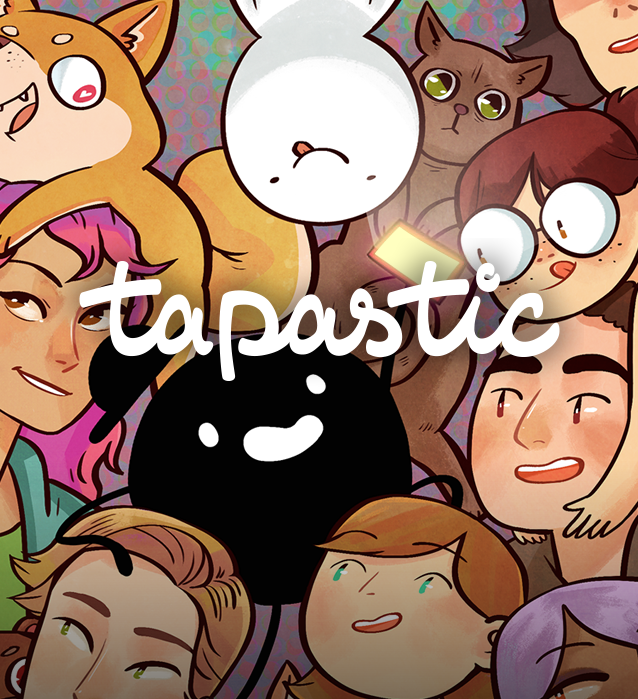by REERA YOO | @reeraboo
editor@charactermedia.com
As one of the most wired countries in the world, South Korea has constant access to some of the fastest high-speed Internet and niftiest smartphone apps. Consequently, Korean web cartoons, or “webtoons,” have swiftly become a popular and powerful storytelling medium over the past decade.
Several webtoons have already been adapted into successful Korean films and dramas, including Misaeng, The Girl Who Sees Smells and Secretly, Greatly.
According to KT Economic Research Institute, major search portals Daum and Naver attract more than 6.2 million webtoon readers daily, and the market size of Korea’s webtoon industry is estimated to double to $800 million by 2018.
However, webcomics have yet to reach that same level of popularity, accessibility and community in the United States—and that’s where Tapastic comes to play.
Billing itself as the “YouTube of webcomics,” Tapastic (a portmanteau of “tapas” and “fantastic”) is a San Francisco-based webcomics portal that offers more than 105,000 comics created by over 5,400 artists worldwide. The company launched only three years ago, but it now boasts $3.4 million in backing from Korean and American investors, including Daum Kakao, SK Planet and former Facebook Chief Technology Officer Adam D’Angelo.
Chang Kim, the founder and CEO of Tapastic, is no rookie when it comes to building new digital platforms. He co-founded TNC, a Korean blogging service that was acquired by Google in 2008, and subsequently worked as a product manager for Blogger. Prior to that, he was a content strategy manager for Samsung Mobile.
Kim recently took time out of his long train commute in San Francisco to speak with KoreAm about Tapastic’s beginnings and growth as well as the globalization of webtoons. The following interview has been edited for length and clarity.
KoreAm: Can you tell us a bit more about Tapastic and its mission?
Chang Kim: Tapastic, in a nutshell, is an open platform and community for comics. For readers, it’s the best service to find and enjoy bite-sized, snackable comics. So overall, Tapastic is like YouTube or SoundCloud, but for comics.
We believe there are so many talented comic creators who want to express their awesome stories in a visual format. Our mission is to build the best platform for these comic creators to share their authentic visual stories, build a strong brand and massive fan base and make money from their creative works.
What inspired you to create this publishing platform for webcomics?
I remember Koreans using social networks, Internet telephony, virtual gifts, online gaming and many other Internet services as early as the late ’90s—when the rest of the world was only beginning to grasp what the Internet was. But the Korean companies that provided those services largely remained in Korea, instead of becoming global brands.
So I really wanted to give it a try myself—namely, spotting an interesting and innovative Internet service model in Korea and taking it to the global market. While researching the Korean market, I found out how crazily popular webtoons were and thought it would be cool to build a webtoon site with global content from global talent. That was the beginning of Tapastic.
Comics artists are able to self-publish their works on Tapastic. What would you say are some of the benefits for these creators?
Tapastic is not just a content publishing site. It is, first and foremost, a thriving community and social network around comics. Fans can not only follow their favorite creators but also support them on a monthly basis. It’s like buying a cup of coffee every month for their favorite creators to show appreciation and help them continue their awesome work.
We really focused on building awesome community, and as a result, we have fantastic community engagement. For example, our site’s overall engagement metrics grew by almost 10 times over the last year or so alone. So the first benefit for comic creators joining our platform would be becoming part of this very enthusiastic community.
We also help creators make money from their content through our monetization features. Creators can earn ads revenue, get monthly support from their fans or sell their completed comic series in our Premium section.
Why do you think webtoons are so popular in South Korea?
It’s simple: Korean webtoons have some of the most amazing stories. That’s how webtoons could attract mainstream users who didn’t necessarily read a lot of comics before (that includes myself), and also why some of Korea’s top TV dramas and movies are based on webtoons. By building an open platform and attracting talented visual storytellers, Korean webtoons were able to build a rich library of awesome stories, similar to the way YouTube attracted many new talents and a massive volume of fresh, high-quality content.
What differentiates Korean webtoons from traditional American comics?
The U.S. has a rich comics tradition. Everybody has fond memories of “mainstream comics,” such as Calvin and Hobbes, which actually once had a great impact on U.S. culture and society in general. But today, the comics industry in the U.S. has become a niche market—think superhero comic books sold in local comic book stores.
Though comics continue to be a major source material for blockbuster movies and TV dramas in the U.S., comics as a medium itself has largely become a niche. We hope Tapastic will help users, especially young millennials on mobile, re-discover the great storytelling power of comics.
There are, in fact, already quite a few popular webcomics in the U.S., such as The Oatmeal. What the U.S. doesn’t have yet is a platform and community like YouTube. That’s what Tapastic is trying to bring about.
Tapastic offers a translation service for its creators, which is a rather unique feature for a webcomics portal. How many series have been translated into another language?
We’ve translated more than 60 high-quality Korean webtoons. Given that webtoons started in Korea, there’s still a lot of great content that has never been introduced to the global audience. Right now, we’re doing translations by ourselves, partly because translating comics in the correct fashion is quite difficult. In the future, we plan to add crowd-sourced translation feature.
Are there any Korean artists from Tapastic who have successfully crossed over to the American market? And are there non-Korean creators who have found success in Korea?
Most of the Korean webtoons that we’ve brought on have been very well received by the American fans, thanks to great art quality and compelling stories. But in this age of social media, content quality is often only half of the equation. Creators that thrive are the ones who actively engage with their fans and constantly communicate with them. Content publishing is increasingly becoming a two-way street.
We’re now starting to see some Korean creators more actively engaging with their fans. Mika is a good example. She’s based in Korea and never published her comics outside of Korea before joining Tapastic, but now her fanbase lies mostly outside of the country. And she’s really actively interacting with her fans.
We’re also planning to introduce high-quality global webtoons to the Korean audience. A Tapastic comic series titled Juju’s Diary, which created by a Brooklyn comic studio, was introduced on Daum’s webtoon section and found great success, which led to the creation of the series’ second season.
Where do you see the medium of webcomics in the next five years? Do you expect to see more international collaborations?
We definitely think webtoons will gain more popularity outside of Korea. The concept of Internet-based open publishing platform and community around visual stories is obviously globally translatable. In the Internet industry there’s the saying, “Mobile is eating the world.“ Mobile Internet is changing people’s lives in a fundamental way (think Uber, for instance), and no industry, including the comics industry, will be spared from those fundamental changes.
Can you recommend some webcomics to our readers who are unfamiliar with the medium?
I personally like comedy series. My personal favorite is Cheer Up, Emo Kid; it’s slightly vulgar, yet crazily witty. I also like Lunarbaboon (I’m a father of two), Sarah’s Scribbles, and Medical Tales Retold (fan-submitted wacky medical stories). In other genres, the amazing art quality of Fisheye Placebo is knocking my socks off every single time I’m reading that comic.
___
You can read more webcomics through the Tapastic website or mobile app (available on iOS and Android). To learn more about Tapastic, visit their Facebook page or follow them on Twitter @tapastic.
All images courtesy of Tapas Media











